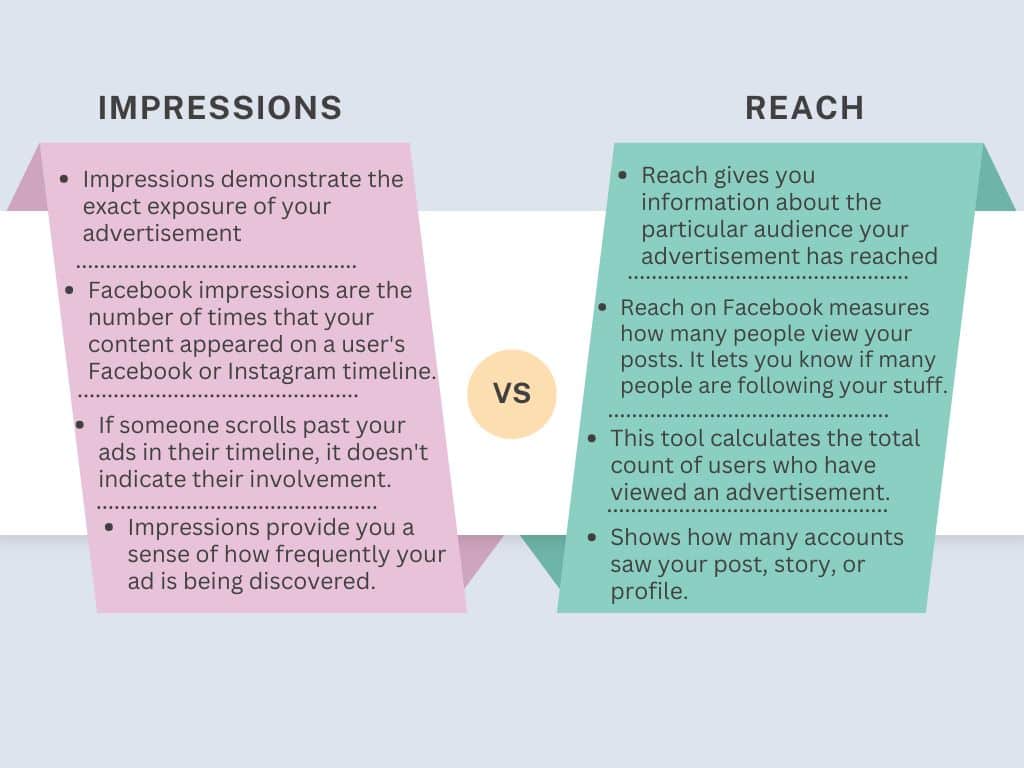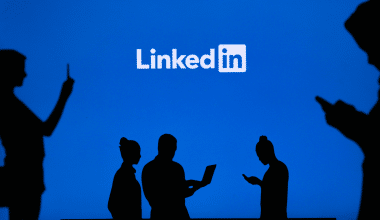For individuals running an online business, it is crucial to clearly understand how their marketing content is performing across various channels. This allows for effective measurement and evaluation of their marketing efforts. In order to accomplish this, one must utilize impressions and reach. When discussing impressions, we are referring to the frequency at which an advertisement or piece of content is displayed, regardless of whether it was clicked on or engaged with. When it comes to the number of people who have come across the content or advertisement, reach is a crucial factor to consider.
Simply put, impressions provide insight into how many times your advertisement was viewed, while reach indicates the number of people who saw it.
Understanding the different metrics can provide valuable insights into your marketing strategies’ effectiveness and potential impact on different platforms. This knowledge allows you to fine-tune and prioritize your strategies to achieve better engagement and conversion rates.
As an experienced user of these tools, I will provide you with a comprehensive discussion on the topic of reach vs impressions. Come along as we explore it further.
Key Points
- Understanding impressions, reach, and engagement is crucial when considering adding or removing information from your marketing dashboard.
- Impressions are the number of times your ad was seen, regardless of viewer interaction.
- The term “reach” refers to the comprehensive evaluation of the unique individuals engaged with your content.
- These two tools can help you evaluate your marketing strategies and improve your policies to increase contact and sales.
- When recognized and analyzed jointly, both data provide a holistic view of your ad’s effect and audience reach.
Impressions Vs Reach Overview
As was already said, impressions and reach are important metrics for marketing analytics, but they measure involvement in different ways.
Firstly, impressions indicate the entire number of times your advertisement has been shown, irrespective of whether engaged with it or not. Impressions count every instance your advertisement is viewed, as well as numerous views by the same person.
“Reach” refers to the total number of unique people who have interacted with and been interested in your content. Reach concentrates on the unique audience and it doesn’t survey multiple views from a particular person.
To put this in plain words, impressions demonstrate the exact exposure of your advertisement, while reach gives you information about the particular audience your advertisement has reached.
These two tools let you evaluate and optimize marketing campaigns to increase interaction and conversion.
Facebook Impressions Vs Reach
When talking about Facebook impressions, that’s how many times your content was seen on someone’s Facebook or Instagram feed.
This is a valuable tool that social media marketers use to keep track of their content performance. By doing so, you’d know if your audience enjoys the content you produce.
If you notice that your impressions and reach are pretty much the same in comparison, it implies your content has gotten through to your audience and captured their attention.
When we talk about reach on Facebook, we are simply trying to know how many people see a post from you. It’s a means to know if several people are keeping up with your content.
Furthermore, the higher the reach, the more people you are able to connect with and your message is sure to get through to them.
Impressions gauge the total number of times a post was seen in a user’s feed. Reach is the total of people who have seen your post maybe once. You must bear in mind that impressions don’t evaluate if the post was read, clicked, or interacted with.
When you use Facebook Ads, you’d be able to compare your impressions and reach for a particular period such as 7 days, 28 days, 12 months, and lots more.
If you are wondering how you’d be able to monitor your Facebook ad impressions and reach, you can easily do this on a dashboard. Create your standards and KPIs for your Facebook Ads campaigns, and track them as well as other social media KPIs from your social media dashboard.
This detailed checklist will help you assess and evaluate your marketing efforts and improve engagement and conversions. Understanding and leveraging impressions and reach will help you make informed decisions to enhance your overall marketing performance.
Impressions Vs Reach vs Engagement
Determining marketing metrics that matter and demonstrating your return on investment (ROI) can feel overwhelming. But this shouldn’t scare you. That’s why we at Lamphill are here for you.
So, getting right into it, although it’s incredible to have a full social media content calendar and a blog overflowing with scheduled posts, if they’re not providing positive feedback and results, why continue with it?
As you’re going through your marketing dashboard looking for information to remove or present, it’s vital to know the differences between the following marketing tools: Impressions, reach, and engagement.
These are some of the marketing tools that are highly common when we are dealing with marketing analytics. Funny enough, they’re not created equally. Walk with me as we discuss further about each of these three marketing tools.
Impressions
You should realize that impressions are the number of times your ad appears on someone’s timeline or feed.
Impressions aren’t actually that meaningful a tool for content marketing ROI, particularly after accessing how most platforms deal with them.
Your ads just need to show up in someone’s timeline, even if the user scrolls right past it, and this isn’t a proper representation of your ad’s engagement impact.
Reach
This tool, on the other hand, has to do with the amount of users who have seen a particular advertisement.
The amount of impressions a content has will often be comparable to or greater than a content reach. Channels such as Facebook normally display content several times to at least some of the content’s target audience.
One thing that will always make an advertisement successful is consistency and repetition. I am sure you are familiar with the “Rule of 7,” a marketing belief that claims a prospect has to typically encounter a message exposed to a message at least seven times before taking action.
But, of course, the number is going to be different depending on the kind of industry, commodity, or service you’re handling. However, as research has demonstrated, in several cases, exposure may result in the prospect liking the content or whatever you are offering them.
Ensure you are very attentive to your impressions-to-reach ratio. You may determine how often to show your content to a target audience on the basis of engagement momentum.
See the contrast clearly in this infographic:

Engagement
Now, for engagement, it outweighs impressions and reach in terms of how important a piece of ad is. Engagement is the action a consumer takes with an advertisement, and it could be something like:
- A click leads to a website
- A social media or website article link
- A report on a blog or social post
- A click of a “buy now” icon on an Instagram photo
Of all the three market metrics tools, engagement is the only one indicating a user is engaging with an advertisement.
When dealing with impressions, there’s no way you’d know if the user looking at a screen is even seeing your content. The same thing happens with reach; a mere encounter might not be so effective, even when a person is shown the same ad many times.
What Engaements Does
Engagement gives you insights into how users are reacting to your advertisement. Maybe a specific call to action is providing more clicks. It could even be that particular content with one type of photo fetches way more engagement than another. These are the things you consider in this game.
As you update content to focus it more on conversions, you’ll need to pay close attention to what aspect of ads people are interacting with.
You’ll want to get the highest engagement without spending much money. If you’re lucky, you won’t need multiple impressions to get significant engagement.
Truthfully, yeah? When you’re carrying out an ad campaign, you must monitor all three of these metrics. I’ll tell you why you should monitor them. These have helped my business. Walk with me, besties:
First off, impressions let you know your content is doing so well and that the network has made it acceptable to show your ads to your target audience. Reach, on the other hand, enables you to know the total number of times people need to see your content before carrying out any action.
Lastly, engagement indicates whether or not your content is getting through to your target audience. When two ads have the same reach-to-impression ratios, you can infer which ads are more active by observing the engagement rate.
If users are seeing your content frequently (low reach, high impressions) but aren’t interacting with your content, you’ll need to either edit it, work on it, or Cease the endeavor to enhance the allocation of your marketing budget.
Basically, though, engagement empowers you with the best understanding of your content performance. It enables you to determine ROI because you can know how much each person’s action is costing you.
Are impressions better than reach?
No, impressions are not better than reach. These two marketing metrics are both highly valuable metrics in advertising, but they fulfill different objectives.
Reach evaluates the total number of unique persons who have encountered your ad, while impressions evaluate the total number of times your ad has been shown, as well as multiple views by a particular person.
Simply put, reach is more expressive of how many people have encountered your ads, while impressions provide you a sense of how frequently your ad is being discovered.
Both tools can be useful depending on your advertising objectives. If you wish to increase brand visibility, reach might be just what you need. If you are all for engagement or content recall, impressions just might be your best bet. All in all, it depends on your particular goals as well as the context of your advertising campaign.
How do you calculate impressions with reach?
If you wish to calculate impressions from reach, you normally multiply the reach by the frequency.
Reach implies the number of unique people who have come in contact with your content, while frequency deals with the average number of times each person has seen your content.
In simple terms, the formula should be:
Impressions = Reach × Frequency
Let’s say, for instance, your content gets to 2000 people with an average frequency of 3 views per person; your total impressions should be 2,000 × 3 = 6,00 impressions. This means your content has been shown a total of 6,000 times.
Is Instagram reach the same as impressions?
No, they’re different metrics on Instagram. Reach here implies the number of unique individuals that have seen your ads, while impressions let you know the total number of times your ad has been displayed and numerous views by the same person or accounts.

Image Credit: Freepik
Let me put it in simple terms :
#1. Reach:
This metric evaluates the different number of accounts that have been exposed to your content. It provides you with insight into how many different accounts have encountered your post, story, or profile. There is only one count for each account, no matter how many times they interact with your content.
#2. Impressions:
Meanwhile, impressions measure every instance in which your ad is shown. This includes numerous views by the same person. It would count as three impressions if the same account saw your post three times.
In essence, reach provides you with insight into how many accounts have encountered your content, while impressions let you know how many times your ad has been seen in total.
Conclusion
While impressions concentrate on the total number of displays, reach stresses the unique accounts reached. Both metrics are useful in evaluating the potency and performance of your ad campaigns, providing different viewpoints on audience interaction and visibility across various platforms.
Recognizing and analyzing Impressions (vs) and Reach metrics together gives a comprehensive perspective of your ad’s impact and audience reach.
Reference
Related Articles
- PR vs. Advertising: Which One Will Skyrocket Your Brand?
- Advertising vs. Marketing: Which Should Your Business Focus On More?
- Marketing vs. Advertising: Building a Growth Engine for Your Business
- PR KPIs: Top 10 PR KPIs Every Comms Pro Needs to Track in 2024
- Monitoring Online Content: How To Do This In 5 Steps






